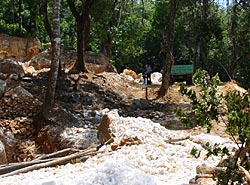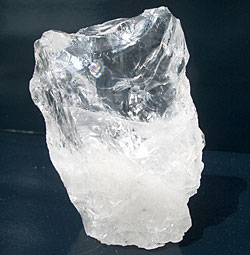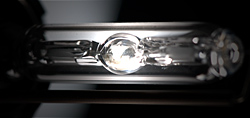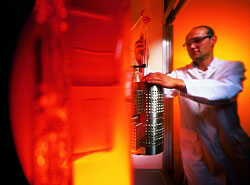
Quartz is one of the most abundant minerals and occurs in many different geological settings. However, only very few deposits are suitable for high purity applications. Therefore, high purity quartz has become one of today’s key strategic minerals with applications in high-tech industries: semiconductors, high temperature lamp tubing, telecommunication and optics, microelectronics, and solar silicon applications.
Beneficiation of raw quartz into refined high purity products involves several steps which need to be adapted to minimize the specific impurities of the individual raw quartz feed in line with end-use applications. As a result, high purity quartz with impurity levels less than 20 ppm may be achieved so creating a valuable raw material which commands up to 5 EUR/kg.
Read more about GPE’s specific know-how in high purity quartz below.
 In the early 1970s, Brazil was the world’s main supplier of high purity quartz based on lascas, a term used to describe manually beneficiated rock crystal. Up to 1974, when the Brazilian government imposed an embargo on exports of lump quartz, export levels rose to in excess of 10,000 tpa. There have been efforts in Brazil to move more into processed high purity quartz supply, led by Mineracao Santa Rosa (MSR), one of the leading lump quartz and lasca suppliers in the country. The other main source of lascas has been Madagascar, which is still producing from small mining operations.
In the early 1970s, Brazil was the world’s main supplier of high purity quartz based on lascas, a term used to describe manually beneficiated rock crystal. Up to 1974, when the Brazilian government imposed an embargo on exports of lump quartz, export levels rose to in excess of 10,000 tpa. There have been efforts in Brazil to move more into processed high purity quartz supply, led by Mineracao Santa Rosa (MSR), one of the leading lump quartz and lasca suppliers in the country. The other main source of lascas has been Madagascar, which is still producing from small mining operations.
Today, US-based Unimin Corp./Sibelco is the most significant producer of high purity quartz worldwide with deposits and operations in North Carolina, USA. One of the few alternative suppliers, Norwegian Crystallites, has been producing high purity quartz from its Drag plant in western Norway and several underground and open pit mines since mid-1996 when the company changed ownership. Following the acquisition of North Carolina K-T Feldspar (2001) and the Feldspar Corporation (2007) by french company Imerys, Norwegian Crystallites and Imerys joined to form the Quartz Corp. in 2011. Quartz raw material for high purity applications is mined just adjacent to one of the Unimin deposits in North Carolina, then shipped and refined into high purity quartz products at its Drag plant in Norway. Crystalline fillers and high purity quartz sand are produced and exported worldwide to the semiconductor, lighting and other industries. Although mined by two companies (Unimin Corp. and The Quartz Corp.), the geographical monopoly with only one major source for high purity quartz located in Spruce Pine, North Carolina, USA persists.
Potential new entrants into the high purity quartz world market are Moscow-based JSC Polar Quartz, with raw material supply based on the Neroika deposit on the eastern slope of the sub-polar (northern) Urals. After many years of stagnancy Rusnano, wholly owned by the Government of the Russian Federation, Ural Industrial Corporation, and Khanty-Mansiysk Autonomous Okrug signed a shareholders’ agreement for the Polar Quartz project in 2011.
Kyshtym Mining (also known as KGOK or Russian Quartz), situated on the Eastern slopes of the South Ural mountains, supplied 60% of domestic high purity quartz demand in the Soviet era. A project to technically refine and re-equip the manufacturing processes started in 2011 with financial support from Rusnano. In 2012 the first production line offering a capacity of 6,000 tons per year for dry concentration has been launched. One year later Rusnano announced its partial exit from Russian Quartz selling it to Sumitomo Corporation, a leading integrated business group headquartered in Japan.
By the end of 2012, Nordic Mining released a Scoping Study, describing the current status of development in the Kvinnherad quartz project. During an advanced test program very low final impurity levels with improved melting behaviour were confirmed and reproduced for samples from different locations in the deposit.
Another recent project development located in Mauretania (North-Western Africa) has been presented by MMC (Mauretania Minerals Company) during the Silica Arabica 2012 event in Jeddah, KSA, with more than 150 quartz veins in the desert area and proven high purity of processed quartz.
Little is known about Chinese Jiangsu Pacific Quartz Co., the biggest lamp tubing producer in China. Although extensive exploration work has been carried out in previous years, only small scale deposits have been indentified calling for selective mining and small output serving share of its own quartz glass production.
Given its strategic relevance in the semiconductor and photovoltaic industry many more high purity quartz projects are under development in Angola, Argentina, Australia, China, India, Kazakhstan, Mauretania, Norway, Saudi Arabia, Ukraine, Vietnam or Turkey to name just a few in which GPE is involved.
 Specific expertise in geology, chemical analysis and high purity processing are required to convert raw mineral quartz into high purity high-value final product. Depending on the geological setting, fluid and/or mineral inclusions need to be removed by applying tailor-made technology. Remnant hydrothermal fluids from which quartz was formed and many different mineral inclusions occur in raw quartz such as iron oxides, phosphates, silicates and heavy minerals.
Specific expertise in geology, chemical analysis and high purity processing are required to convert raw mineral quartz into high purity high-value final product. Depending on the geological setting, fluid and/or mineral inclusions need to be removed by applying tailor-made technology. Remnant hydrothermal fluids from which quartz was formed and many different mineral inclusions occur in raw quartz such as iron oxides, phosphates, silicates and heavy minerals.
Depending on the final quality and value, processing of the raw quartz into high purity quartz involves advanced comminution technology, physical, thermal and chemical steps. Comminution reduces raw quartz to liberate mineral impurities and to required product size. Further physical and chemical steps are needed to separate or dissolve the impurities.
Besides laboratory scale equipment, GPE provides a local test plant for the production of high purity quartz samples which allows production of up to 1,000 kg sample quantities.
This plant also permits leaching of silica by hydrofluoric acid. All auxiliaries such as classifiers and drying equipment have been tuned to high purity conditions so allowing the reliable processing of high purity raw materials on a semi-technical scale. At the GPE test plant, technical samples are produced for customer tests as well as for end user approval.
Electrodynamic comminution is an enhanced technology to liberate high purity quartz crystals from composite rock largely without contamination and with low loss of undersize particles.
A high-voltage discharge generates shock waves within the quartz lump causing fragmentation of the rock along crystal boundaries. Since crystal boundaries host most of the mineral impurities, downstream processing is more efficient and expected yield increases significantly compared with mechanical comminution techniques. Moreover, selective fragmentation technology is ideal to selective liberation of gas and fluid inclusion trails within the quartz crystals. All this makes electrodynamic comminution a favored method in high purity quartz processing.
![]() Chemical refining is one of the most efficient operations to reduce mineral impurities in high purity quartz. During acid treatment, medium to strong mineral acids are used at elevated temperatures. Usually hydrofluoric acid is applied, but a combination of several acids can be used (HF, HCl, HNO3) to improve chemical purification results.
Chemical refining is one of the most efficient operations to reduce mineral impurities in high purity quartz. During acid treatment, medium to strong mineral acids are used at elevated temperatures. Usually hydrofluoric acid is applied, but a combination of several acids can be used (HF, HCl, HNO3) to improve chemical purification results.
Connate minerals (e.g. feldspars, micas), difficult to liberate during physical processing, are dissolved in the course of leaching. Additional impurities, enriched in micro fissures and structural dislocations, can be removed by the  enhanced dissolution of quartz. This kind of purification procedure is regularly applied in lamp tubing as well as semiconductor applications of high purity quartz.
enhanced dissolution of quartz. This kind of purification procedure is regularly applied in lamp tubing as well as semiconductor applications of high purity quartz.
 Hot chlorination is a highly advanced technique for achieving exceptional high purity. During the chlorination process high purity quartz is heated to temperatures up to 1,200°C in a chlorine or hydrogen chloride gas atmosphere. Chlorination causes structural impurities to be forced from the crystal lattice into the gas phase. Chlorination is particularly efficient for the reduction of alkali, alkali earth, and transition metals.
Hot chlorination is a highly advanced technique for achieving exceptional high purity. During the chlorination process high purity quartz is heated to temperatures up to 1,200°C in a chlorine or hydrogen chloride gas atmosphere. Chlorination causes structural impurities to be forced from the crystal lattice into the gas phase. Chlorination is particularly efficient for the reduction of alkali, alkali earth, and transition metals.
GPE has a hot chlorination test facility – a highly valuable tool to validate and optimize the chlorination process specific to the mineralogical, physical and chemical properties of the raw material. Variations in gas composition, reaction temperature and duration determine optimum parameters for the material undergoing hot chlorination. Thus a maximum purity of the quartz is achieved in order to fulfill the stringent requirements of the semiconductor industry.
Read More >>
- 61 S Main St, Greenville, SC 29601, USA
- 1 (843) 258-9824
- Mon - Fri: 9:00 - 18:00